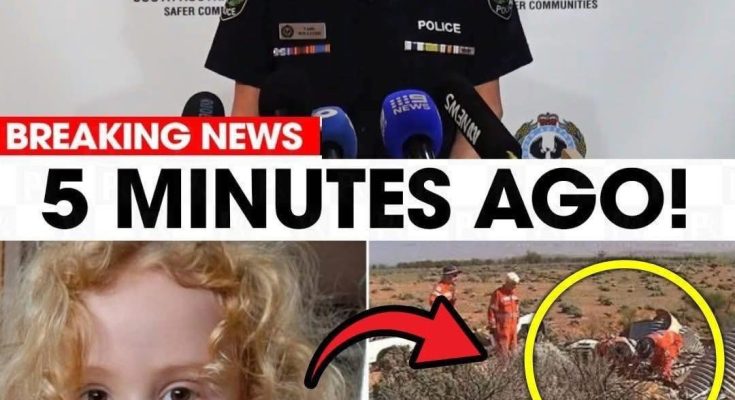How does a four-year-old boy vanish from a familiar sheep farm, surrounded by people who loved him, without leaving a single trace? That’s the haunting question echoing across South Australia tonight — and the one that will likely never have a satisfying answer.
For ten days, the nation watched, prayed, and hoped as hundreds scoured the rugged, sun-scorched terrain south of Yunta, searching for little Gus Lamont, a boy described as curious, gentle, and endlessly energetic. His disappearance on September 27, 2025, turned an isolated pastoral property into the center of one of the largest and most desperate search operations in recent Australian history.
By the time authorities called off the rescue phase, the mood had shifted from hope to heartbreak. And yet, even with all the technology and manpower at their disposal, searchers were left with nothing — not a scrap of clothing, not a footprint, not a clue.
The Day He Disappeared
It began like any other day on the Lamont family’s sheep station — a sprawling, dusty property about 40 kilometers south of Yunta. The afternoon sun was still high when Gus’s grandmother saw him last, around 5:00 p.m. He’d been playing near a dirt mound just outside her house, a familiar spot where he liked to dig and pretend to hunt for “fossils.”
When she called him in for dinner roughly half an hour later, there was no response. At first, she assumed he’d wandered to the back paddock or gone chasing after one of the dogs. But as the minutes passed and the stillness settled in, dread began to grow.
By nightfall, the family had alerted police. Within hours, the quiet outback property became a hub of flashing lights, vehicles, and coordinated movement — the beginning of what would become a massive multi-agency effort to find one small child.
The Search
What started as a small, local search quickly escalated into a full-scale operation involving South Australia Police, State Emergency Service volunteers, the Australian Defence Force, and even Aboriginal trackers known for their ability to read the faintest signs of movement across harsh terrain.
Helicopters circled overhead. Drones equipped with thermal imaging swept over hundreds of hectares of bushland. Ground teams walked shoulder-to-shoulder through thickets of mulga scrub and open plains. Horses, ATVs, and four-wheel drives combed the property and beyond.
By day two, more than 150 personnel were on the ground. The search area had expanded to 60 square kilometers — a staggering amount of territory, considering Gus’s small size and the harsh environment he’d have faced alone.
Temperatures swung brutally from daytime heat to freezing nights. The terrain was rough, rocky, and often deceptive — the kind of landscape that could easily disorient even an adult.
Despite the immense effort, the results were chillingly empty.
Nothing. Not a Single Sign.
No footprints that could be confirmed as his. No discarded item of clothing. No signs of an animal encounter or accident.
As one volunteer later said, “It was like the land swallowed him.”
Each passing day brought renewed waves of both manpower and heartbreak. Locals from nearby towns joined in, bringing food, water, and fuel to search teams. Some came just to help the family in quiet ways — fixing fences, preparing meals, or sitting beside Gus’s parents in the sleepless nights.
And still, nothing.
By day nine, search coordinators made the devastating announcement that the mission would be scaled back, transitioning from rescue to recovery.
A Community Shattered
The heartbreak rippled far beyond Yunta. Across the country, families followed updates on radio and online, their hearts breaking for the parents who waited for news that never came.
Even seasoned searchers were shaken. One crew member, speaking through tears, told reporters, “We don’t want to accept it. Every one of us came out here hoping we’d be the one to find him. We kept telling ourselves, ‘He’s tough. He’s smart. He’s hiding somewhere.’ But the longer it went on, the harder it became to hold onto that.”
When the official statement was released declaring the operation a recovery effort, the words hit like a physical blow: “Based on the terrain, time elapsed, and lack of evidence, the likelihood of survival is extremely low.”
Still, many searchers refused to leave. Volunteers stayed behind after hours, walking the same paths again and again, unwilling to give up.
Questions That Won’t Go Away
How does a child disappear in such a way — without a trace, without a sound, within sight of home?
Investigators have floated every possible scenario. Could Gus have wandered off and fallen into a hidden mine shaft or animal burrow? Could he have been taken by someone passing through the area — unlikely, given the isolation? Could a wild animal have been involved?
So far, police have found no evidence to confirm or eliminate any theory.
One detail that haunts the case is the timing. Gus vanished in broad daylight, within minutes, on a property surrounded by open land. No tire tracks, no witnesses, no sounds of struggle.
It’s the kind of mystery that keeps even the most rational minds awake at night.
The Weight of Silence
For the Lamont family, every day since has been a battle against that silence. The once-bustling farm has become eerily quiet — the sound of helicopters replaced by the wind through the trees, the chatter of volunteers replaced by the endless question: What happened to Gus?
Neighbors continue to visit, bringing food and comfort, though words feel empty. “There’s nothing you can say,” one friend said. “You just sit with them. That’s all you can do.”
Authorities have pledged that the investigation remains open and active, with specialized teams continuing to review data from drones, mapping software, and heat imaging used during the operation. But as the days stretch into weeks, hope has given way to the harsh reality that closure may never come.
Remembering Gus
Those who knew him describe Gus as a spark of light — a boy who loved the outdoors, who followed his grandfather around the farm pretending to “help” with the sheep, and who could talk endlessly about dinosaurs. His favorite color was green, and he was rarely seen without a wide-brimmed hat two sizes too big for his head.
At just four years old, he had an imagination too big for his small world.
The community has since organized vigils in nearby towns, lighting candles and placing small toy trucks and stuffed animals in his memory.
A Nation’s Heartbreak
Australia has faced its share of tragedies, but the disappearance of a child strikes a different kind of chord — one that resonates in every household. Parents hold their kids a little tighter. Farmers lock their gates. Everyone, even strangers, feels the same helpless ache.
In the words of one police officer involved in the search, “It’s not just one family’s loss. When something like this happens, the whole country feels it.”
And so, the question remains, echoing through the red dust of the South Australian outback:
Where is Gus Lamont?
Until that answer comes — if it ever does — his name will remain carved into the hearts of everyone who walked those miles of dirt and hope, refusing to stop until they had to.
Because sometimes, even when you can’t bring someone home, you keep searching — if only to prove you never gave up.



